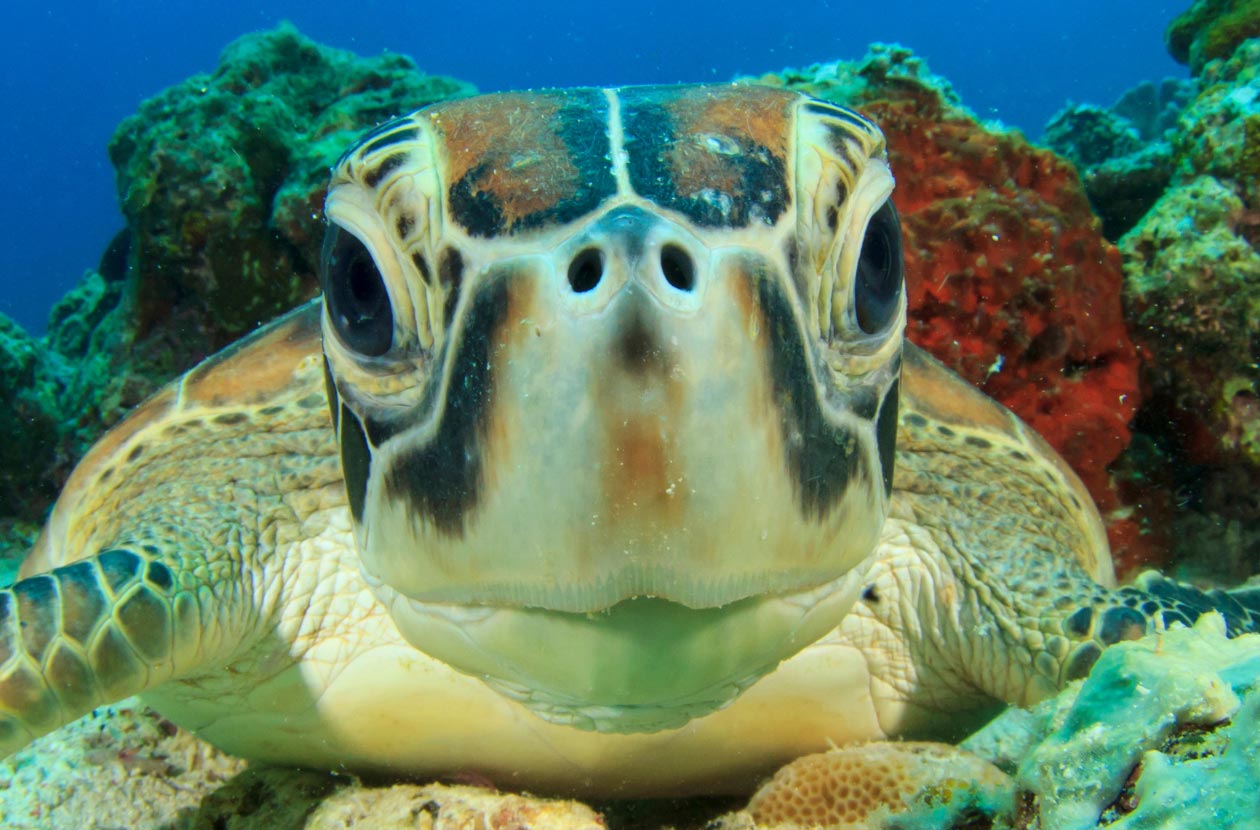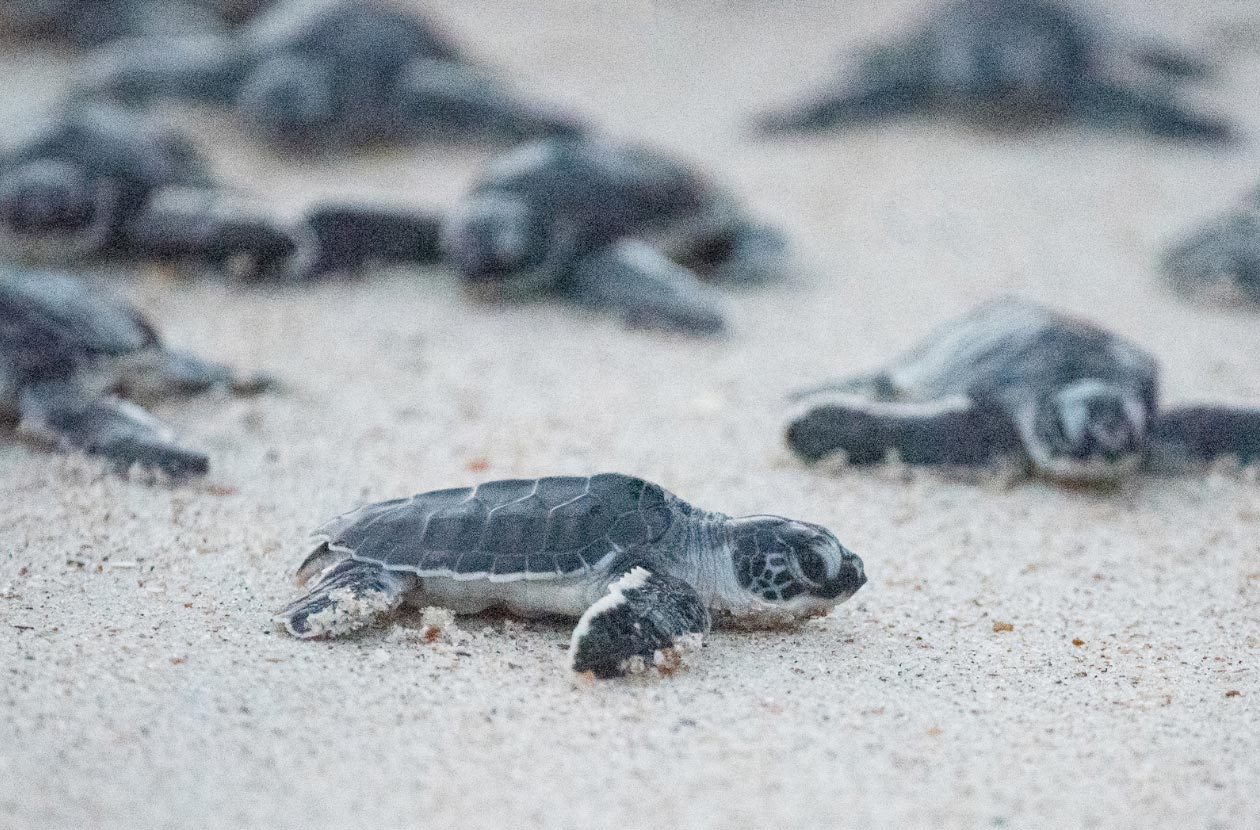The green turtle, scientifically known as Chelonia mydas, is an enchanting creature that resides in the world’s oceans. Its distinctive green coloration and remarkable life cycle have fascinated researchers and nature enthusiasts alike. In this article, we will delve into the captivating world of the green turtle, exploring its habits, the threats it faces, and its occurrence in different regions.
Green Turtle – Habitat and Migration
The green turtle is a marine reptile that inhabits tropical and subtropical waters around the globe. Its habitat includes coral reefs, seagrass beds, and shallow coastal areas where it finds ample food and nesting sites. Green turtles are known for their remarkable migrations, often traveling long distances between feeding and breeding grounds. These migrations are crucial for their survival and reproductive success.
Green Turtle – Feeding Behavior
Green turtles are primarily herbivorous, with a diet consisting mainly of seagrasses and algae. They play a crucial role in maintaining the health of seagrass beds by controlling the growth of vegetation and promoting nutrient cycling. Their feeding behavior involves grazing on seagrass meadows and scraping algae from rocks and coral. The shape of their beak-like jaws and powerful jaws allow them to efficiently consume their preferred food sources.

Can green turtles breathe underwater?
Green turtles are reptiles and, like other turtles, they have lungs and breathe air. Unlike fish, which extract oxygen from water using gills, green turtles must come to the surface of the water to breathe. They have adapted to spending extended periods of time underwater by being able to hold their breath for long periods. When a green turtle dives underwater, it relies on the oxygen stored in its lungs. It can stay submerged for several hours, depending on the activity level and other factors. During this time, the turtle’s heart rate slows down, and its metabolism decreases to conserve oxygen.
Once the oxygen stored in the lungs is depleted, green turtles need to return to the surface to breathe. They come up for air, exhale, and then quickly inhale fresh air before diving back underwater. This cycle repeats as they alternate between diving and surfacing for breath. It’s worth noting that while green turtles cannot extract oxygen directly from the water like fish, they are excellent swimmers and have adapted to their marine environment in various ways, including their ability to hold their breath and stay submerged for extended periods.
Reproduction and Life Cycle
The reproductive journey of green turtles is awe-inspiring. Adult females return to the beaches where they were born to lay their eggs, a behavior known as natal homing. After digging a nest in the sand, they lay a clutch of around 100 to 200 eggs and carefully cover them before returning to the sea. The eggs incubate for approximately two months, and then the hatchlings emerge and make their way to the water. They face numerous challenges during this perilous journey, including predation and disorientation caused by artificial lights.
How long do green turtles live?
Green turtles are known to have a long lifespan, with some individuals living for several decades. The exact lifespan of a green turtle can vary depending on various factors such as environmental conditions, predation, disease, and human impact. However, it is generally believed that green turtles can live for 60 to 80 years on average.
There have been reports of green turtles living even longer in exceptional cases. Some individuals have been documented to live up to 100 years or more. However, it is important to note that determining the precise age of a turtle is challenging and often relies on estimating based on growth rates and size.
It is worth mentioning that the survival and longevity of green turtles are greatly influenced by human activities and conservation efforts. Factors such as habitat destruction, pollution, entanglement in fishing gear, and poaching pose significant threats to their populations. Conservation initiatives and protected areas play a crucial role in safeguarding these magnificent creatures and ensuring their long-term survival.

Threats to the Green Turtle
Despite their remarkable adaptations, green turtles face several significant threats that endanger their survival. One of the most pressing threats is habitat destruction, particularly the degradation of nesting beaches and feeding areas. Climate change poses another significant challenge, as rising temperatures can skew the sex ratio of hatchlings and disrupt the delicate balance of ecosystems. Additionally, entanglement in fishing gear, poaching, pollution, and marine debris all contribute to the decline of green turtle populations.
Do green turtles have any natural predators?
Yes, green turtles have natural predators in their marine and terrestrial habitats. Some of the main natural predators of green turtles include:
- Sharks: Large predatory sharks, such as tiger sharks and great white sharks, are known to prey on green turtles, particularly when they are in the ocean.
- Saltwater Crocodiles: In some regions, such as the northern coast of Australia, saltwater crocodiles are known to attack and consume green turtles.
- Killer Whales (Orcas): Orcas are intelligent and powerful marine predators that have been observed hunting and feeding on green turtles in certain areas.
- Land Predators: While green turtles primarily spend their time in the ocean, adult females come ashore to lay their eggs. During this vulnerable period, they can face predation from animals such as monitor lizards, raccoons, and feral dogs or pigs that may dig up and consume their eggs.
It’s important to note that the threats posed by human activities, such as habitat destruction, pollution, and poaching, are considered to be the most significant factors impacting green turtle populations worldwide. Conservation efforts are crucial to protect these turtles from both natural predators and human-induced threats.
Conservation Efforts
To safeguard the future of green turtles, conservation efforts have been implemented worldwide. These initiatives focus on protecting nesting sites, establishing marine protected areas, and promoting sustainable fishing practices. Strict regulations have been put in place to reduce accidental capture in fishing gear, and educational campaigns raise awareness about the importance of conserving these remarkable creatures. International agreements and collaborations also play a crucial role in coordinating conservation efforts across borders.
How can I contribute to the conservation of green turtles?
There are several ways you can contribute to the conservation of green turtles and help protect these endangered creatures. Here are some suggestions:
- Support Conservation Organizations: Research and find reputable conservation organizations that work specifically with green turtle conservation. Consider donating to these organizations or volunteering your time and skills to support their efforts.
- Spread Awareness: Educate others about green turtles, their importance in marine ecosystems, and the challenges they face. Use social media, organize awareness campaigns, or give presentations at schools or community events to raise awareness about their conservation needs.
- Adopt Eco-friendly Practices: Reduce your carbon footprint and minimize your impact on the environment. Practice sustainable habits such as conserving energy and water, reducing single-use plastics, and choosing environmentally-friendly products. Small changes in our daily lives can have a positive cumulative impact on the environment.
- Participate in Clean-up Activities: Organize or join beach clean-up activities in your area. Removing litter and debris from beaches and coastal areas helps create a safer environment for turtles and prevents them from ingesting or getting entangled in marine debris.
- Be Responsible While Visiting Coastal Areas: If you visit beaches where green turtles nest, follow guidelines provided by local authorities or conservation organizations. Avoid disturbing nesting sites, keep a safe distance from turtles, and do not touch or interfere with them. Responsible tourism helps protect their natural behavior and nesting habitats.
Remember, the conservation of green turtles requires collective effort, and every individual action counts. By supporting conservation organizations, raising awareness, practicing sustainable habits, and being responsible in coastal areas, you can make a positive impact on the protection and survival of green turtles and their habitats.

Occurrence of Green Turtle
Green turtles can be found in various parts of the world, inhabiting both coastal and offshore waters. They are known to frequent regions such as the Caribbean, the Mediterranean Sea, the Great Barrier Reef, the Galapagos Islands, and the coasts of Southeast Asia. These areas provide suitable conditions for feeding, nesting, and migration, ensuring the survival of green turtle populations.
Are green turtles endangered?
Yes, green turtles are considered endangered. The International Union for Conservation of Nature (IUCN) lists the green turtle (Chelonia mydas) as an endangered species. This classification signifies that green turtles face a high risk of extinction in the wild if adequate conservation measures are not implemented.
Several factors have contributed to the decline of green turtle populations. Habitat destruction, including the loss of nesting beaches due to coastal development and pollution, is a significant threat. Additionally, the incidental capture of turtles in fishing gear, such as nets and longlines, poses a serious risk. Pollution, climate change, and the collection of eggs and adult turtles for their meat, shells, and other products are additional factors that have contributed to their endangered status.
Conservation efforts are being undertaken globally to protect and restore green turtle populations. These efforts include habitat protection, implementing fishing regulations to reduce bycatch, establishing marine protected areas, and raising public awareness about the importance of conservation. These initiatives aim to reverse the decline of green turtles and ensure their long-term survival in their natural habitats.
The Importance of Green Turtles in Ecosystems
Green turtles have a profound impact on marine ecosystems. Their feeding behavior helps maintain the health of seagrass beds, which are essential habitats for numerous species. By grazing on seagrasses, green turtles prevent them from becoming overgrown and promote biodiversity. Moreover, their movements between different habitats contribute to the exchange of nutrients and the dispersal of seeds, influencing the overall balance of coastal ecosystems.

Interaction with Humans
The relationship between green turtles and humans is multifaceted. In some cultures, green turtles hold cultural and spiritual significance and are revered as symbols of wisdom and longevity. However, human activities, such as coastal development and pollution, have put these remarkable creatures at risk. Responsible tourism and sustainable fishing practices are essential in minimizing the negative impact on green turtle populations. By understanding and respecting their habitat needs, we can ensure a harmonious coexistence.
The Future of Green Turtle
The conservation efforts and initiatives dedicated to protecting green turtles offer hope for their future. By addressing the threats they face, implementing sustainable practices, and raising awareness, we can contribute to the recovery of green turtle populations. Collaboration between governments, scientists, local communities, and individuals is crucial in securing a brighter future for these magnificent creatures.
Green Turtle – let’s recap
In conclusion, the green turtle captivates with its vibrant appearance and remarkable life cycle. Through this article, we have explored its fascinating habits, the threats it encounters, and its occurrence in various regions. By understanding the challenges green turtles face and taking action to protect them, we can ensure their survival for generations to come. If you want to dive with turtles, be sure to read this text: Diving with Turtles at Isla del Caño in Costa Rica



